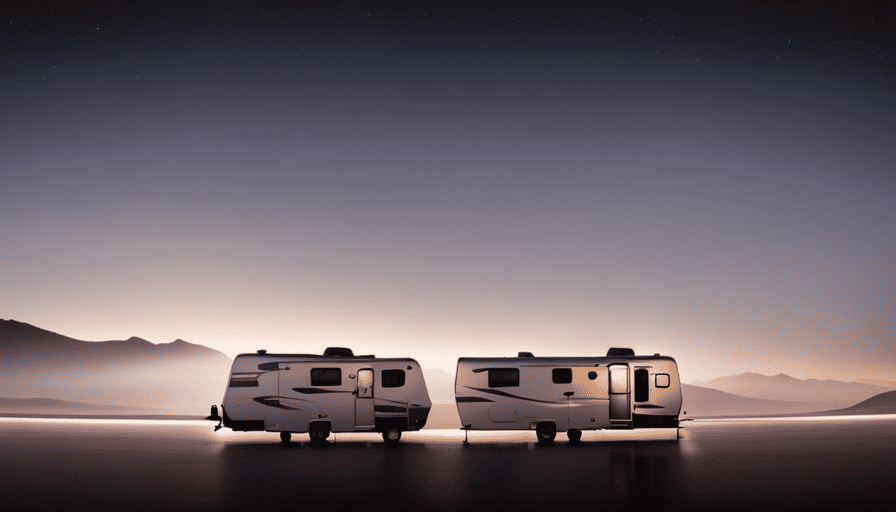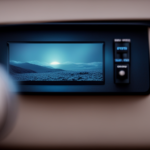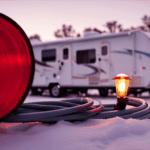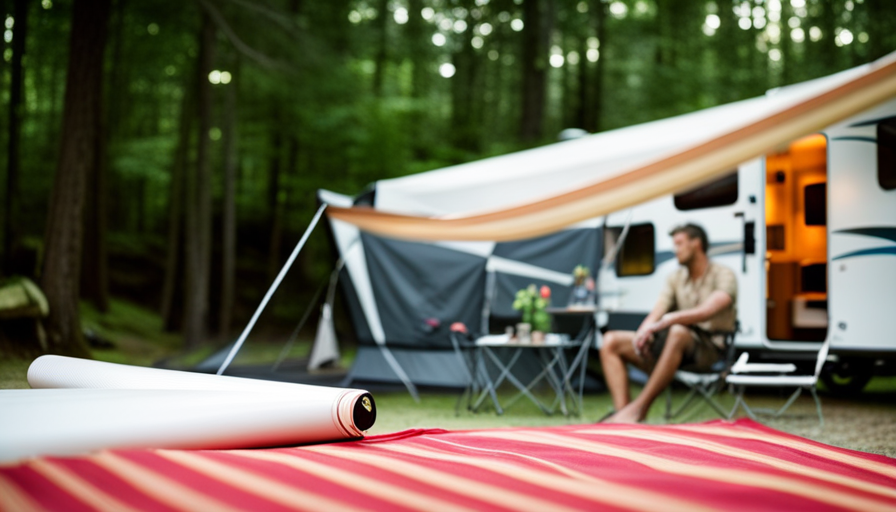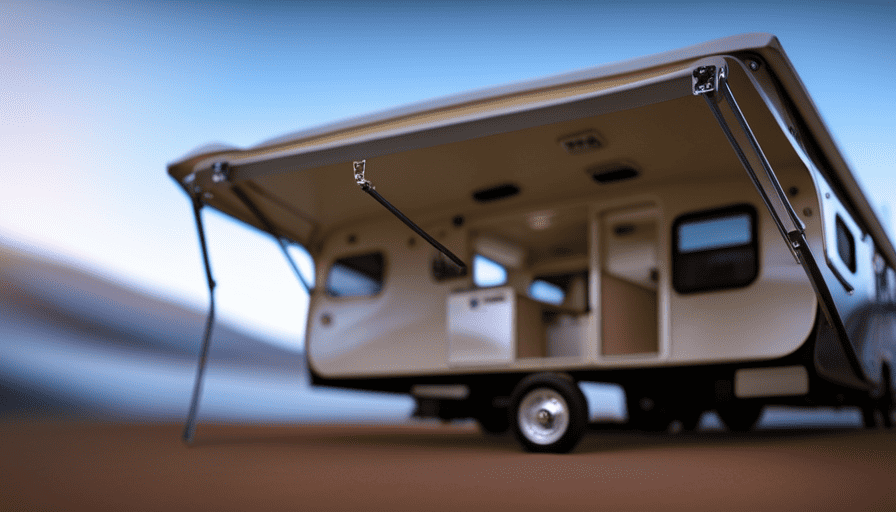Have you ever imagined setting off on an exciting journey, exploring beautiful scenery, and enjoying the liberty of the open road? If that’s the case, then you might have thought about transforming a camper van into your personal roaming haven.
However, one crucial aspect of van life that often goes overlooked is how to effectively heat your cozy abode on wheels. Fear not, for I am here to guide you through the intricacies of heating a camper van, ensuring that you stay warm and comfortable regardless of the weather outside.
From assessing your heating needs and preferences to considering the different types of heating options available, I will provide you with expert advice on everything you need to know.
So, let’s dive in and discover the secrets to creating a toasty haven within your beloved camper van.
Key Takeaways
- Choose the most suitable heating option for your camper van based on efficiency, cost-effectiveness, and availability of fuel or electricity.
- Proper insulation and ventilation are essential for heat retention and safety in a camper van.
- Utilize portable electric heaters, propane heaters, or diesel heaters for effective heating solutions.
- Regular maintenance of the heating system, including checking filters, vents, and ducts, is crucial for optimal performance and longevity.
Assess Your Heating Needs and Preferences
Before you hit the road, take a moment to figure out your heating needs and what will make you feel cozy and comfortable in your camper van. It’s important to consider the heating system efficiency and cost-effective heating solutions that are available to you.
When it comes to heating a camper van, there are several options to choose from. One option is a propane heater, which is a popular choice due to its efficiency and affordability. Propane heaters are easy to install and provide a consistent source of heat.
Another option is a diesel heater, which is known for its efficiency and ability to heat larger spaces. Diesel heaters are also cost-effective and can run off the same fuel as the vehicle, making them convenient for long trips.
Consider the different types of heating options available for your camper van. From propane heaters to diesel heaters, there are solutions to fit every budget and preference. It’s important to choose a heating system that meets your specific needs and provides the level of comfort you desire.
So, let’s dive into the different options and find the perfect heating solution for your camper van.
Consider the Different Types of Heating Options
When outfitting your mobile home, it’s crucial to explore the various heating options available to ensure you stay cozy and warm during your travels.
There are several different types of heating options to consider:
-
Propane Heater: Propane heaters are a popular choice for camper van owners due to their efficiency and ease of use. These heaters use propane gas to generate heat and can be easily installed and operated. They come in various sizes and can provide a consistent source of warmth.
-
Diesel Heater: Another option to consider is a diesel heater. These heaters are highly efficient and can run off the vehicle’s diesel fuel supply. They are known for their low fuel consumption and ability to heat large areas quickly. Diesel heaters are also relatively quiet, making them ideal for a peaceful night’s sleep.
-
Electric Heater: If you have access to electricity, an electric heater can be a convenient option. These heaters are easy to install and operate, and they provide instant heat. However, it’s important to consider the power requirements and ensure your electrical system can handle the load.
Considering the different types of heating options available will help you choose the best one for your camper van. Once you have determined the size and power requirements, you can move on to the next step of outfitting your mobile home.
Determine the Size and Power Requirements
To determine the size and power requirements for your mobile home, you’ll need to consider factors such as the square footage of your space and the average temperature you’ll be camping in. It’s important to ensure that your heating system can effectively warm up your entire camper van.
Did you know that a 1500-watt electric heater can effectively warm up to 150 square feet of area? This is a good starting point when considering the power consumption and heating efficiency of different heating options.
When selecting a heating system for your camper van, it’s crucial to choose one that matches the size of your living space. A heater that is too small may struggle to keep your camper warm, while one that is too large may consume excessive power and lead to wasted energy. Understanding the power requirements and heating efficiency of different heaters will allow you to make an informed decision.
Now that you have determined the size and power requirements for your camper van heating system, it’s time to ensure proper ventilation and safety measures. By taking the necessary precautions, you can enjoy a cozy and safe camping experience.
Ensure Proper Ventilation and Safety Measures
Make sure you prioritize the safety and comfort of your mobile home by ensuring proper ventilation and taking necessary precautions. Ventilation is of utmost importance when heating a camper van, as it helps to circulate fresh air and prevent the buildup of harmful gases such as carbon monoxide.
To achieve proper ventilation, consider installing windows or vents that can be opened and closed as needed. This will allow for a constant flow of air while also giving you control over the temperature inside the van. Additionally, it’s crucial to have a carbon monoxide detector installed to alert you of any potential leaks or dangers.
Safety precautions should also be taken to prevent accidents and fires. Make sure that any heating appliances are properly installed and maintained. Avoid using open flames or unvented heaters, as they can pose serious risks in a confined space like a camper van. Furthermore, always follow the manufacturer’s instructions when using heating devices and never leave them unattended.
By ensuring proper ventilation and taking necessary safety measures, you can enjoy a comfortable and safe heating experience in your camper van. As we move forward, let’s explore how to insulate your camper van for better heat retention.
Insulate Your Camper Van for Better Heat Retention
Insulating your mobile home can significantly improve its ability to retain warmth, with studies showing that properly insulated spaces can reduce energy consumption by up to 50%.
When it comes to insulating your camper van, it’s essential to assess the effectiveness of the existing insulation and make necessary upgrades. Start by checking for any gaps or areas where heat may escape, such as windows, doors, and vents. Seal these areas with weatherstripping or caulking to prevent heat loss.
Next, choose suitable materials for insulation. Options include foam board, spray foam, or reflective insulation. Foam board is a popular choice as it provides excellent thermal resistance and is easy to install. Consider the R-value of the insulation material, which measures its ability to resist heat flow. The higher the R-value, the better the insulation.
Additionally, insulation should be applied to both the walls and the ceiling of your camper van for optimal heat retention. With a well-insulated space, you can ensure a comfortable and cozy environment during colder months.
Moving forward to the next section about installing a thermostat for temperature control, it’s important to have an efficient way to regulate the heat inside your camper van.
Install a Thermostat for Temperature Control
Installing a thermostat in your mobile home enhances climate control, allowing you to easily adjust the temperature to your desired comfort level. Here are three key benefits of thermostat installation and some tips to help you get started:
-
Improved Energy Efficiency: With a thermostat, you can set specific temperature ranges, ensuring your camper van doesn’t waste energy by constantly running the heater. It’ll turn on and off as needed, saving you money on fuel or electricity.
-
Enhanced Comfort: A thermostat allows you to maintain a consistent temperature throughout your camper van. No more waking up in the middle of the night feeling too cold or too hot. You can set the thermostat to your preferred temperature, providing a cozy environment for a good night’s sleep.
-
Remote Control Capability: Many thermostats now come with remote control features, allowing you to adjust the temperature from your smartphone. This means you can warm up your camper van before you even step inside, ensuring a comfortable experience right from the start.
When it comes to thermostat installation, make sure to choose a model that’s compatible with your heating system. Follow the manufacturer’s instructions carefully, and if you’re unsure, consult a professional.
Now, let’s move on to the next section and explore how to utilize portable heating solutions without compromising safety.
Utilize Portable Heating Solutions
Say goodbye to shivering in your cozy mobile oasis by utilizing nifty portable heating solutions that will keep you toasty warm without compromising safety. When it comes to heating your camper van, there are two main options to consider: portable electric heaters and propane heating solutions. Let’s take a closer look at each of these options and how they can help you create a comfortable living space on the road.
Portable electric heaters are a popular choice for camper van owners due to their convenience and ease of use. These heaters come in various sizes and styles, allowing you to find the perfect fit for your van. They are typically lightweight and compact, making them easy to store and transport. With adjustable temperature settings and built-in safety features such as tip-over protection, portable electric heaters offer a reliable and efficient way to heat your camper van.
On the other hand, propane heating options provide a more traditional and powerful heating solution. These heaters use propane gas to generate heat, making them ideal for colder climates or longer trips where electric hookups may not be available. Propane heaters can quickly warm up your camper van and provide a cozy atmosphere inside. However, it’s important to ensure proper ventilation and follow safety guidelines when using propane heaters.
By incorporating portable electric heaters or propane heating options into your camper van, you can create a warm and comfortable living space on the go. Now, let’s move on to the next section and explore how to create a cozy sleeping area with insulated bedding.
Create a Cozy Sleeping Area with Insulated Bedding
When it’s time to catch some Z’s in your cozy mobile oasis, make sure to create a snug sleeping area with insulated bedding. A well-insulated mattress is key to keeping warm during those chilly nights on the road. Not only does it provide a comfortable surface to sleep on, but it also acts as a barrier between you and the cold air underneath your camper van. Invest in a high-quality insulated mattress that’ll keep you warm and cozy throughout the night.
To enhance the warmth of your sleeping area even further, consider using electric blankets. These blankets are designed to generate heat and can be easily adjusted to your desired temperature. Snuggling up under an electric blanket is a surefire way to ensure a toasty night’s sleep, regardless of the outside temperature.
The soft, plush feel of insulated bedding creates a sense of comfort and coziness that’ll make you feel right at home.
The added warmth provided by electric blankets not only keeps you comfortable, but it also promotes better sleep by relaxing your muscles and soothing your body.
Now that you’ve created a warm and inviting sleeping area with insulated bedding and electric blankets, it’s time to take it a step further and use heat reflective window coverings. [Transition sentence into the subsequent section]
Use Heat Reflective Window Coverings
To create a cozy sleeping area in your camper van, insulated bedding is essential. But to further enhance the insulation efficiency and keep the temperature inside optimal, it’s crucial to use heat reflective window coverings. These coverings not only provide privacy but also act as a barrier against external temperature fluctuations.
By reflecting the sun’s rays and preventing heat from escaping, heat reflective window coverings help maintain a comfortable temperature inside your van. They are usually made of materials like Mylar or aluminum, which have excellent heat reflecting properties. These coverings can be easily attached to the windows using suction cups or magnets, ensuring a snug fit.
In addition to reducing heat loss, heat reflective window coverings also help in preventing cold drafts from entering the van. This creates a more efficient and comfortable environment for sleeping or relaxing during colder nights.
To better understand the benefits of heat reflective window coverings, take a look at the table below:
| Benefits of Heat Reflective Window Coverings |
|---|
| 1. Reflects the sun’s rays |
| 2. Prevents heat from escaping |
| 3. Reduces cold drafts |
| 4. Maintains a comfortable temperature |
| 5. Enhances insulation efficiency |
By incorporating heat reflective window coverings into your camper van, you can significantly improve the insulation and create a warmer and cozier atmosphere. And now, let’s move on to the next topic: regularly maintain and check your heating system to ensure its optimal performance.
Regularly Maintain and Check Your Heating System
Regularly maintaining and checking the heating system is crucial for ensuring optimal performance and a comfortable living environment in your mobile home. Keeping your heating system in good condition not only helps to provide warmth during cold seasons but also prevents potential issues that may arise.
To ensure the efficiency and longevity of your heating system, here are some maintenance tips to consider.
Firstly, it’s important to regularly check the air filters. Dirty or clogged filters can reduce the airflow, making your heating system work harder and less efficiently. Clean or replace the filters as recommended by the manufacturer to maintain proper airflow and maximize performance.
Furthermore, inspect the vents and ducts for any obstructions or leaks. Clear any debris or blockage that may hinder the airflow and ensure that the ducts are properly sealed to avoid heat loss. Additionally, inspect the blower motor and lubricate it if necessary, as a well-lubricated motor operates more efficiently.
Lastly, schedule professional maintenance checks at least once a year. A trained technician can perform a thorough inspection, clean the system, and identify any potential issues before they become major problems.
Regularly maintaining and checking your heating system will not only keep your camper van cozy and warm but also extend the lifespan of your heating system, saving you money in the long run. By following these maintenance tips, you can ensure optimal performance and a comfortable living environment throughout your travels.
Frequently Asked Questions
Can I use a portable electric heater as my primary heating source in a camper van?
Yes, you can definitely use a portable electric heater as your primary heating source in a camper van. However, it’s important to consider the pros and cons compared to a propane heater.
The main advantage of an electric heater is that it’s convenient and doesn’t require fuel or ventilation. On the other hand, propane heaters are more powerful and can provide heat even in remote areas. Additionally, electric heaters may drain your battery faster, so it’s essential to have a backup power source.
Are there any specific safety measures I should take when using a propane heater in a camper van?
When it comes to using a propane heater in your camper van, safety should be your top priority. Proper maintenance of the propane heater is essential to ensure its safe operation. Regularly check for any leaks or malfunctions, and always have a carbon monoxide detector installed.
Additionally, make sure to provide proper ventilation to prevent a buildup of harmful gases. Remember, "Better safe than sorry!"
How can I prevent condensation build-up in my camper van when using a heating system?
To prevent condensation build-up in my camper van when using a heating system, I recommend implementing effective insulation techniques. Proper insulation can help regulate the temperature inside the van, reducing the chances of condensation forming on surfaces.
Insulating the walls, ceiling, and floor with materials like foam or reflective insulation can create a barrier that prevents heat transfer and minimizes condensation. Additionally, using thermal curtains or window coverings can further improve insulation and prevent cold spots.
What are the benefits of using heat reflective window coverings in a camper van?
Energy efficient window coverings, such as heat reflective window coverings, offer numerous benefits for camper van owners. These coverings are designed to reflect heat away from the windows, helping to keep the interior cool in hot weather. This not only enhances comfort but also reduces the need for excessive air conditioning, saving energy and extending battery life.
Additionally, these window coverings can provide privacy and block out unwanted sunlight, allowing for a more enjoyable camping experience. As alternatives, some people opt for thermal curtains or insulated blinds, but heat reflective window coverings are often the most effective choice.
How often should I clean and service my camper van’s heating system to ensure it functions properly?
To ensure proper functioning of my camper van’s heating system, I adhere to a regular cleaning schedule and maintenance checklist. Cleaning the system at least once a year helps remove any built-up debris or dust that could hinder its performance.
Additionally, I inspect and service the heating components, such as the furnace, vents, and ducts, to ensure they’re in optimal condition. Following this cleaning and maintenance routine keeps my heating system running efficiently and ensures a comfortable camping experience.
Are the Methods for Heating a Camper Van the Same as Heating a Regular Camper?
When it comes to heating options for campers, the methods for heating a camper van may differ from those used in a regular camper. While both types of campers can utilize propane heaters or diesel heaters, camper vans may have the added option of using electric heaters due to their smaller size and available power sources. It is essential to consider the specific heating needs and capabilities of your camper before choosing the appropriate heating method.
Conclusion
As I sit here in my toasty camper van, I can’t help but feel a sense of satisfaction. The warmth envelops me like a comforting hug, symbolizing not just physical comfort, but also the fulfillment of my adventurous spirit.
By carefully assessing my heating needs, considering different options, and ensuring proper ventilation and safety measures, I’ve created a cozy sanctuary on wheels. So, whether you’re embarking on a winter road trip or living the van life full-time, take these steps to heat your camper van and embrace the warmth of endless possibilities.


